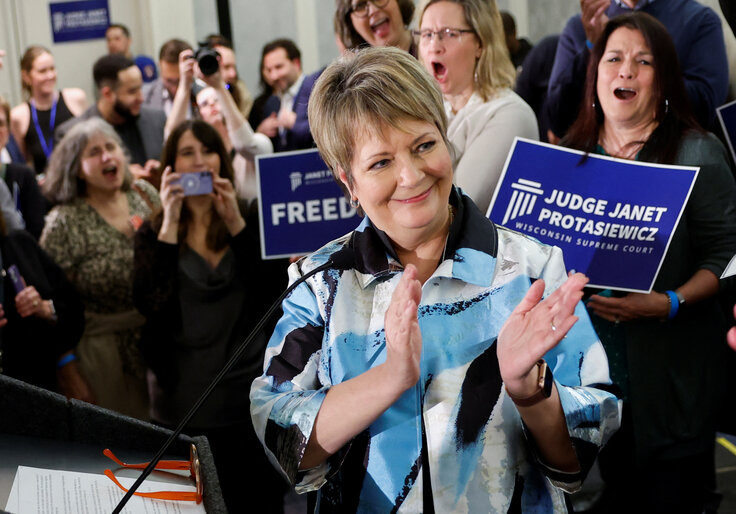The Wisconsin State Supreme Court election on April 4 was filled with idiosyncrasies. The winner, liberal candidate Janet Protasiewicz, will determine ideological control of the court and the future of state abortion and election law. She outspent her conservative rival, Daniel Kelly, by millions of dollars, defining him early as an anti-abortion extremist aligned with Donald Trump's MAGA movement.
Kelly had been rejected by voters before, in 2020, and hadn't exactly spent the intervening years moderating his views or improving his favorability rating. The Badger State, of course, is as swingy as you can get: It went for Trump in 2016 by about 23,000 votes and Biden in 2020 by about 20,000; boasts a Democratic governor and a Republican legislative supermajority; and has a U.S. senator from each party. Its House delegation is 6-2 Republican—partially thanks to congressional maps Protasiewicz may soon throw out.
Protasiewicz defeated Kelly by a whopping 11 points. She successfully framed the election as a referendum on Wisconsin's current no-exceptions abortion ban, which went into effect last summer when the U.S. Supreme Court overruled Roe v. Wade. Wisconsin governor Tony Evers has challenged the ban in court. Protasiewicz has made it clear that she's ready to strike it down. Her state's electorate is too.
The election reinforced two political trends. The first is that if voters believe abortion is on the ballot, they will mobilize to protect access to it. That is what happened in Kansas last summer and, among other places, in Michigan last November. The centrality of abortion is what explains the difference in outcome between this week in Wisconsin and last November's Senate race.
Both contests took place after the end of Roe. And yet, six months ago, Republican pro-life senator Ron Johnson of Wisconsin was narrowly reelected over his state's then-lieutenant governor, Democrat Mandela Barnes. Why did Johnson win by 1 point while Kelly lost by 11? Because Johnson had plenty else to talk about, including President Biden's job performance, inflation, and crime.
The judicial election presented a binary choice on a single issue. Nor did it help Kelly that the Wisconsin abortion ban is total. Even pro-choice polling data show that voters are willing to restrict abortion—as long as provisions are made for rape, incest, and life of the mother. Remove those conditions, and the public veers in a pro-choice direction. "What you have to do is argue for protections that the American people see as reasonable versus the extremism of no exceptions, even late-term abortion," GOP strategist Frank Cannon told the AP recently. "And if you do that, it's a winning combination."
Winning combinations are proving difficult for Republicans these days. Republicans still flourish in a post-Roe world—look at the GOP House, and Governors Ron DeSantis, Brian Kemp, Glenn Youngkin, and Mike DeWine, for starters—but only if they draw support from middle-class voters in the suburbs.
Which is why the second trend underscored by the Wisconsin Supreme Court race ought to alarm the GOP. Kelly failed to mobilize the Republican vote in Wisconsin's "WOW" counties: Waukesha, Ozaukee, and Washington. While Kelly did win these historically Republican Milwaukee suburbs, he did so by considerably smaller margins than Johnson in 2022. Johnson, for example, won Waukesha County by 25 points; Kelly won by 16. Johnson won Ozaukee County by 16 points; Kelly won by 4. And Johnson won Washington County by 42 points; Kelly won by 32. The drop-off cost him the election.
If Republicans dominate in rural precincts and Democrats in urban enclaves, then the suburbs are majority makers. Yet the suburbs have been receding from the GOP since the dawn of the Trump era.
Consider: In 2014, the last election before Trump descended on his escalator, Republicans won the suburban vote 55 percent to 45 percent. They won both the white non-college vote and the white college vote by double digits. They won voters making between $50,000 per year and $100,000 per year by 10 points.
By the end of Barack Obama's presidency, majorities among suburban white voters near the middle of the income distribution fueled the GOP's greatest electoral strength in close to a century. Unease over Trump shrank this coalition in 2016: Republicans won the suburbs by 5 points, white non-college voters by 39 points, white college voters by 4 points, and middle-income voters by 4 points. That gave Trump the Electoral College, but not a popular vote majority.
Then Trump entered office. He retained his support among white voters without college degrees in 2018. But the remaining pillars of Republican rule crumbled beneath him. White voters with college degrees voted for Democrats by 4 points. Middle-income voters went for Democrats by 2 points. And the suburbs turned against Republicans, voting Democratic by 11 points.
The same pattern was visible in the 2020 results: Trump won non-college white votes (though by a smaller margin than four years earlier). White college voters went for Joe Biden by 7 points. Middle-income voters split evenly between the parties. And the suburbs voted for Biden by 10 points.
In 2022, non-college white voters turned out for Republicans once more, but Democrats won white college voters by 1 point and the suburbs by 1 point. Middle-income voters returned to the Republican column, 52 percent to 45 percent. The narrowing demographic gaps produced the mixed result of a Republican House and Democratic Senate.
If Republicans were serious about winning Arizona, Georgia, and Wisconsin in 2024 and thus the White House, they would try to add white voters with college degrees and suburban America atop their non-college rural base. To do so, they would have to replace Donald Trump as party leader. They would have to find a nominee who is pro-life and who can speak about abortion restrictions—with exceptions for rape, incest, and life of the mother—in a nonthreatening way. They would have to learn the lessons not only of Wisconsin this week, but of every election cycle since 2016. And they would have to move quickly, before 2024 escapes the GOP's grasp.
